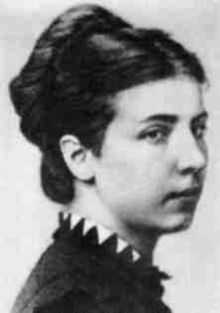Elisabeth Dmitrieff

Elisabeth Dmitrieff (real name: Elizabeta Luknichna Tomanovskaya (née Kusheleva); Russian: Елизавета Лукинична Томановская (née Кушелева); 1 November 1851, Volok, now in Pskov Oblast – 1910 or 1918) was a Russian-born feminist and actress of the 1871 Paris Commune. Born Elisaviéta Loukinitcha Koucheleva, she was a co-founder of the Women's Union, created on 11 April 1871, in a café of the rue du Temple, with Nathalie Lemel.
Life
Elisabeth Dmitrieff was the daughter of a Tsarist official.[1] She was active in her youth in the Socialist circles of Saint Petersburg. In 1868, she travelled to Switzerland, and co-founded the Russian section of the First International.[1] Delegated to London, she met Karl Marx there, who sent her in March 1871, aged 20, to cover the events of the Commune.
Dmitrieff finally became an actress of these events, founding with Nathalie Lemel the Women's Union on 11 April 1871. She dedicated herself especially to political questions and the organisation of cooperative workshops.[1]
Elisabeth Dmitrieff participated to the Socialist newspaper La Cause du peuple. After having fought on the barricades during the Bloody Week, she fled to Russia. Once arrived in her native country, she married a political prisoner in order to help him avoid death penalty, and decided to follow him in deportation in Siberia, where she ended her days.[1]
Commemoration
The 3rd Arrondissement's municipal council decided on 27 March 2006 to give her name to a little square, between the rue du Temple and the rue de Turbigo (close-by to the Place de la République).[2] The square Elisabeth Dmitrieff was inaugurated on 8 March 2007, for the International Women's Day, along with the squares Nathalie Lemel and Renée Vivien (in the same arrondissement).
See also
References
- ↑ 1.0 1.1 1.2 1.3 François Bodinaux, Dominique Plasman, Michèle Ribourdouille. "On les disait 'pétroleuses'..." (French)
- ↑ Municipal council decision of 27 March 2006 (French)
External links
- Héroïnes révolutionnaires russes du XIXe siècle, images, stéréotypes, mythes, pour quelles histoires?, by Sylvie Braibant, mémoire of History DEA at the École des hautes études en sciences sociales, 1992 (French)
|